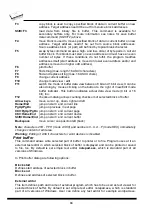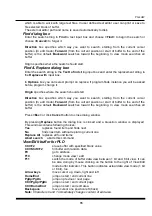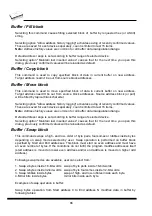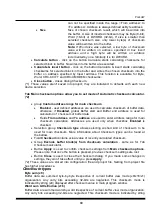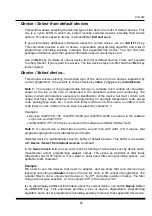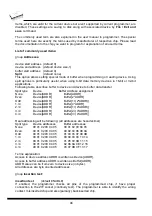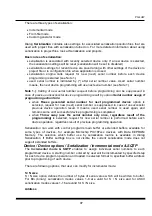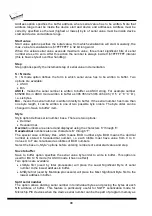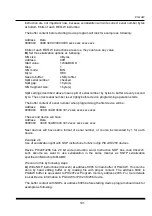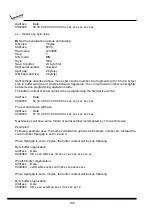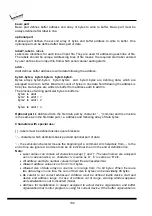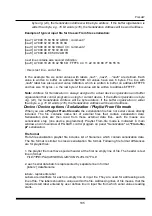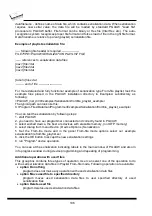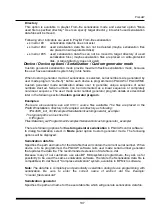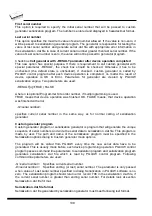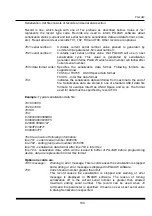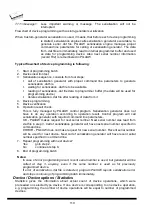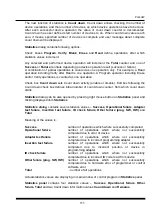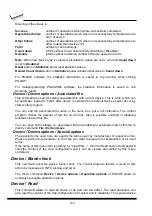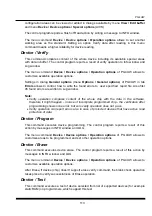
98
Address option specifies the buffer address, where serial value has to be written. Note that
address range must be inside the device start and device end addresses. Address must be
correctly specified so the last (highest or lowest) byte of serial value must be inside device
start and device end address range.
Start value
Start value option specifies the initial value, from which serialization will start. Generally, the
max. value for serialization is $1FFFFFFF in 32 bit long word.
When the actual serial value exceeds maximum value, three most significant bits of serial
number are set to zero. After this action the number is always inside 0..$1FFFFFFF interval
(this is basic style of overflow handling).
Step
Step options specify the increment step of serial value incrementation.
S / N mode
S / N mode option defines the form in which serial value has to be written to buffer. Two
options are available:
ASCII
Bin
ASCII
- means the serial number is written to buffer as ASCII string. For example number
$0528CD is in ASCII mode written to buffer as 30h 35h 32h 38h 43h 44h (‘0’ ‘5’ ‘2’ ‘8’ ‘C’ ‘D’),
i.e. six bytes.
Bin
- means the serial number is written directly to buffer. If the serial number has more than
one byte length, it can be written in one of two possible byte orders. The byte order can be
changed in „Save to buffer“ item.
Style
Style option defines serial number base. There are two options:
Decimal
Hexadecimal.
Decimal
numbers are entered and displayed using the characters '0' through '9'.
Hexadecimal
numbers also use characters 'A' through 'F'.
The special case is Binary Dec, which means BCD number style. BCD means the decimal
number is stored in hexadecimal number, i.e. each nibble must have value from 0 to 9.
Values A to F are not allowed as nibbles of BCD numbers.
Select the base in „Style“ options before entering numbers of serial start value and step.
Save to buffer
Save to buffer option specifies the serial value byte order to write to buffer. This option is
used for Bin S / N mode (for ASCII mode it has no effect).
Two options are available:
LSByte first
(used by Intel processors) will place the Least Significant Byte of serial
number to the lowest address in buffer.
MSByte first
(used by Motorola processors) will place the Most Significant Byte first to the
lowest address in buffer.
Split serial number
The option allows dividing serial number into individual bytes and placing the bytes at each
Nth address of buffer. This feature is particularly useful for SQTP serialization mode for
Microchip PIC devices when the device serial number can be the part of program memory as
Summary of Contents for Dataman-40Pro
Page 7: ...Quick Start 7 Introduction ...
Page 12: ...12 Quick Start ...
Page 15: ...Detailed description 15 Detailed description ...
Page 16: ...16 DATAMAN 448PRO2 ...
Page 30: ...30 DATAMAN 48PRO2 DATAMAN 48PRO2C ...
Page 45: ...DATAMAN 40PRO 45 DATAMAN 40PRO ...
Page 54: ...54 DATAMAN MEMPRO ...
Page 61: ...Setup 61 Setup ...
Page 72: ...72 PG4UW ...
Page 141: ...PG4UWMC 141 PG4UWMC ...
Page 154: ...154 Installation procedure customized ...
Page 159: ...Common notes 159 Common notes ...
Page 171: ...Troubleshooting and warranty 171 Troubleshooting and warranty ...

